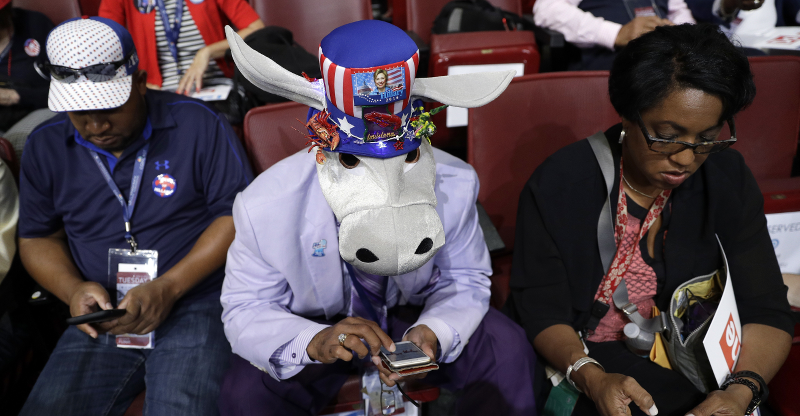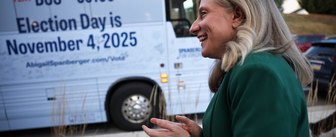Hello, I'm Will Jordan and welcome to The Pulse.
Today I’m reporting directly from Philadelphia, where thousands of Democrats have gathered to make their pitch to the country –
- Wait, first, is Donald Trump winning now?
Glad we can get this out of the way. Yes, a couple of post-convention polls have shown Donald Trump ahead, including one widely reported poll showing a big 10-point net shift towards the GOP nominee. But others showed only marginal change or no change at all including YouGov’s weekly national tracking poll. The polls that make for the easy story – Trump Bounces Into the Lead! NO Convention Bounce For Trump! – understandably, if sometimes egregiously end up the story.
As usual, the reality is probably somewhere in between. And anyway, it's probably worth waiting a couple weeks until after the Democrats have had their convention before deciding where the race really stands.
Another tip: some of the swings showing up in polls right now might be a mirage. - A mirage?
I'll get back to the convention in a moment. But first, let me introduce you to the concept of differential response rates, if you two haven't met already. The crux of this effect is that certain major events – like the opposing party’s convention – temporarily depress people and make them less inclined to talk to pollsters, even though their vote doesn't change. In a 2014 study, researchers (full disclosure: one of them is Doug Rivers, chief scientist at YouGov) surveyed a panel of voters on multiple occasions and corrected for this bias, and found “nearly constant levels of support” even over the most tumultuous moments of the race. Along those lines, a review of YouGov’s 11-state Battleground Tracker, which interviewed a group of likely voters using similar methods, found Trump gaining two points out of the large pool of undecided voters. So, it's a bounce, but probably a modest one. - So, what do you learn at a convention?
If the impact of conventions on vote intentions is more modest than thought, you might wonder what difference they do make. As discussed last week, rallying partisan voters is a goal of the political theater. But a lot of the show is to establish the tone and address the that the party expects will win them the election. The RNC featured a lot of anti-Hillary messages, and a lot of doom-and-gloom. “Only I can fix it,” was Trump’s aspirational twist. The DNC has seen plenty of Trump-bashing, but the focus has been on humanizing Hillary and setting an optimistic tone – as exemplified by a line from Michelle Obama’s speech (which received the best reception in the convention all of any speech so far): “don’t let anyone ever tell you that this country isn’t great”. - Will it work?
Well, improving Clinton’s image at least a little is probably a necessary condition for victory – but in and of itself is not sufficient. But one problem with the sanguine tone some in the party have set out is that not all Democrats, not to mention independents and Republicans, agree with it. The party is sharply divided between those who think the country is heading in the right direction (42% last weekend) – led by those who have supported Clinton and Barack Obama most strongly – and those who think the country has veered off track (48%). Among the latter group are those who have responded most passionately to Bernie Sanders and Elizabeth Warren and their vision of a rigged political system in need of fundamental reform. The resistance to a message of continuity likely plays a role in their resistance to Clinton, who deliberately cast herself as a continuity candidate to (successfully) win over the most pro-Obama voters. - What’s next?
By Tuesday, that resistance to Clinton, in the form of “Bernie or Bust” loyalists who booed through nearly every speech on Monday, appeared to drift out of the convention hall both figuratively and literally as the former First Lady and Secretary of State was formally nominated by Bernie Sanders himself. But importantly, those who walked out were a very small group in the crowd, which is overwhelmingly positive or at least polite about the nominee. And in the latest YouGov/Economist Poll – even though 44% disapprove of Sanders’s Clinton endorsement – the share of Bernie Sanders voters who “prefer” Clinton over Trump rose nearly 20 points, from 59% to 78% in a week. Many of the issues, like the Trans-Pacific Partnership, or TPP, certainly animate activists, but are not a priority for many regular voters. So it seems likely the party, and the convention, can move on. Wednesday night at the DNC has a theme of national security, which, as the Trump campaign has noticed, was largely absent from the messages of the first two nights of political theater. It would be a glaring omission at a time when national security and terrorism are the number one and two issues for voters nationwide, and when 40% of Americans think an imminent domestic terror attack is “very likely”.
We’ll see if she can hit those notes.
If you’re at the convention and want to speak about the election in person, get in touch!
Extra reading:
- Nate Cohn at the Upshot pinpoints the one demographic that is hurting Hillary Clinton relative to Obama's performance in 2012.
- Pew Research data suggests 9 in 10 "consistent Sanders supporters" support Clinton over Trump
- But will they turnout? Sanders voters are disproportionately non-traditional voters, according to 538.
- ICYMI: I looked at opinions of NATO, which reveal surprising splits across – rather than along – party lines
The Pulse is a weekly newsletter YouGov has launched ahead of the 2016 primaries and general election to give readers a one-stop-shop for the latest polling-related news from the campaign. In addition to YouGov’s own extensive coverage of the election, The Pulse gives you the five things you need to know about the state of the campaign each week.








